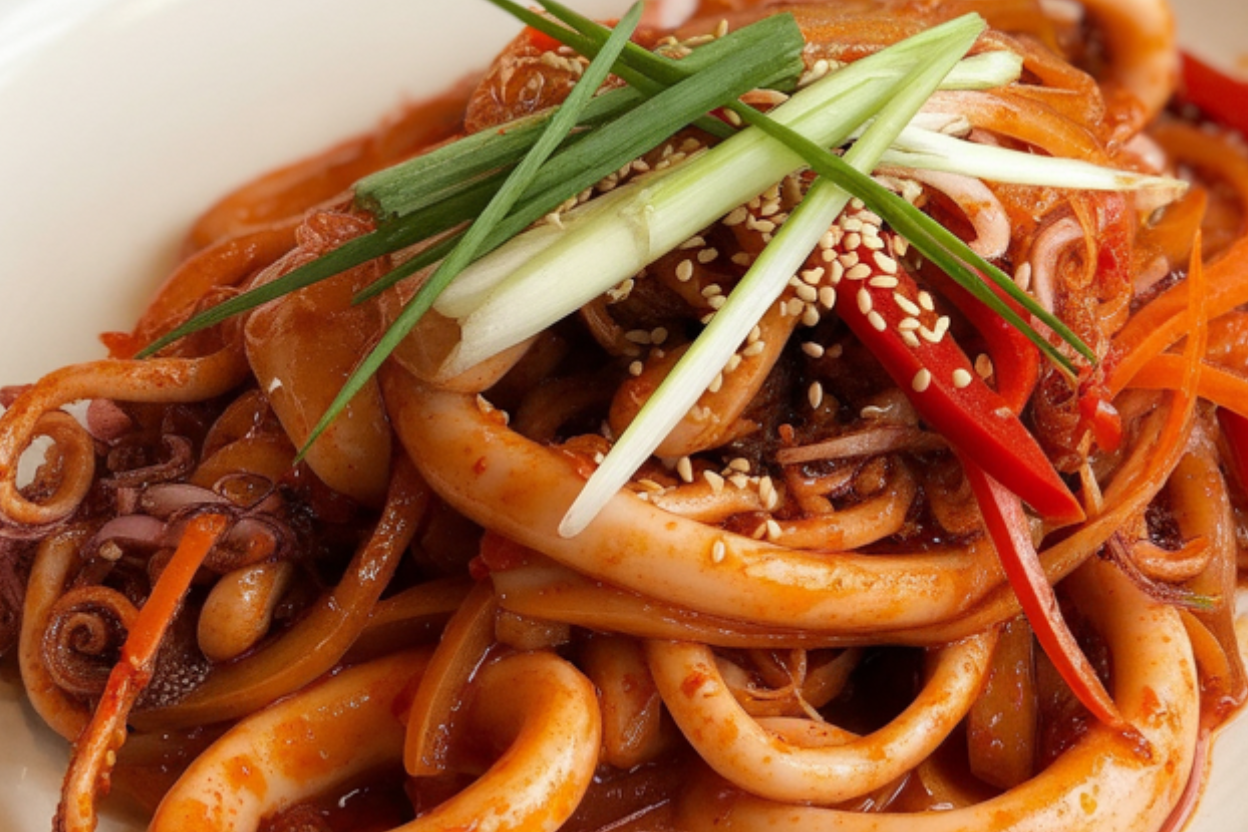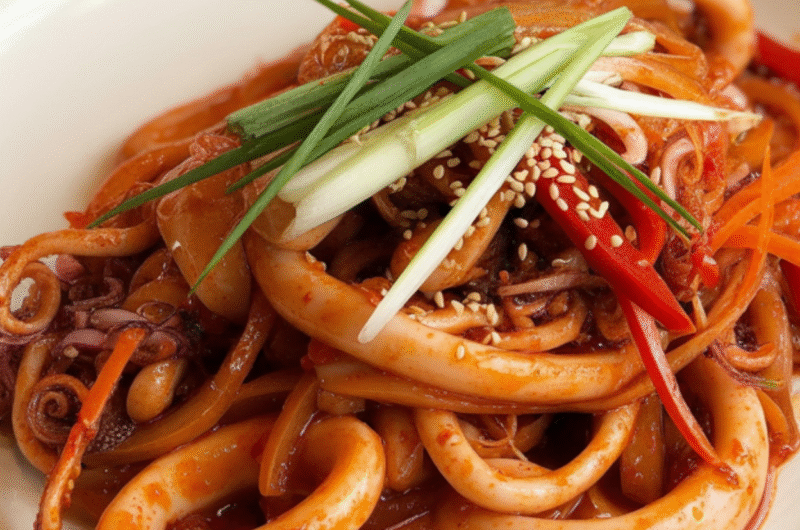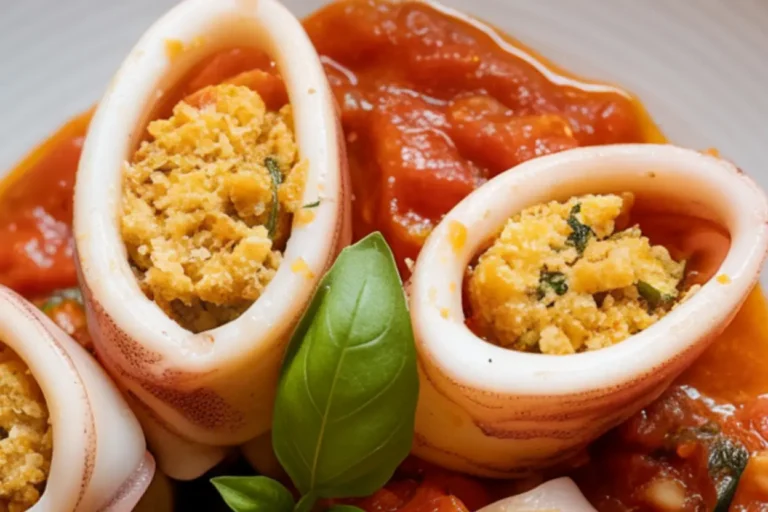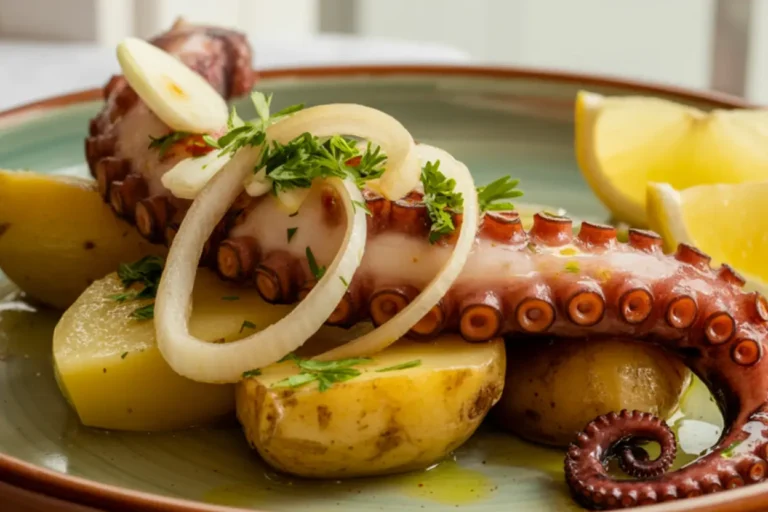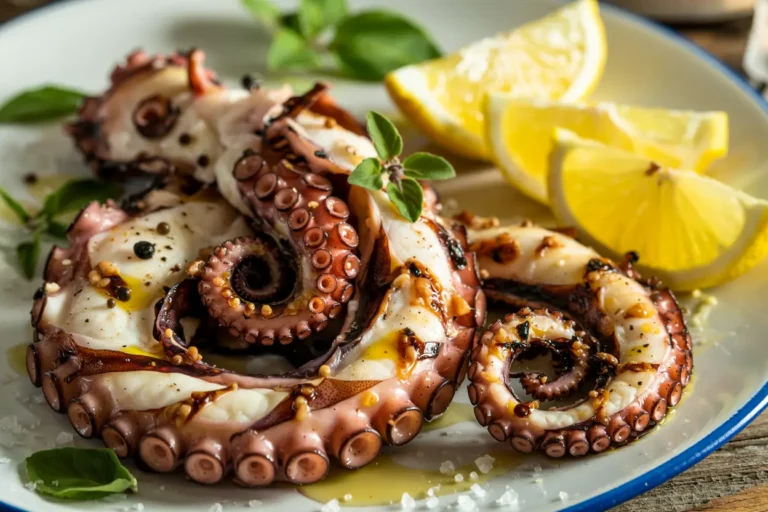Korean Spicy Stir-Fried Squid: How to Get It Tender Every Time
Table of Contents
There’s something irresistible about the combination of tender squid, vibrant vegetables, and the bold, spicy-sweet flavors of Korean cuisine. After years of testing and perfecting seafood recipes, I can confidently say that mastering Korean Spicy Stir-Fried Squid (ojingeo bokkeum) is a game-changer for your home cooking repertoire. This dish delivers an explosion of flavor with a fraction of the effort you might expect from something so impressive.
Thank you for reading this post, don't forget to subscribe!What many home cooks struggle with, however, is achieving that perfect squid texture – tender with just the right amount of chew, never rubbery or tough. I’ve refined the techniques to ensure foolproof results every time, making restaurant-quality Korean squid accessible to anyone, regardless of their experience level with seafood or Korean cooking.
Whether you’re looking to expand your culinary horizons, impress dinner guests with something unexpected, or simply want to enjoy this beloved Korean classic at home, this comprehensive guide will take you through every step to create a dish that rivals any you’d find in Korea’s best restaurants.
How to Make Korean Spicy Stir-Fried Squid
Quick Overview
Korean Spicy Stir-Fried Squid (ojingeo bokkeum) delivers a thrilling combination of tender squid and crisp vegetables in a sauce that masterfully balances spicy, sweet, and savory notes. What makes this dish truly special is how the gochujang-based sauce caramelizes slightly during high-heat cooking, creating complex flavors that coat each piece of perfectly cooked squid. The vibrant colors alone make this an impressive dish, but it’s the harmonious interplay of textures and flavors that makes it unforgettable.
The beauty of this recipe lies in its efficiency – despite its complex flavor profile, it comes together in just about 30 minutes total (15 minutes of prep and 15 minutes of cooking). The quick cooking time is actually essential to achieving that ideal squid texture. Cooked properly, squid should be tender with a slight chew – never rubbery – and the techniques in this recipe ensure perfect results every time.
Perhaps most impressive is how this dish delivers such bold, satisfying flavors while remaining relatively light and healthy. The sauce packs an intense punch that eliminates any need for excessive oils or fats, making this a protein-rich meal you can feel good about. The combination of tender squid, crisp vegetables, and that distinctive Korean spice blend creates a crave-worthy dish that will quickly become a regular in your cooking rotation.
The Ingredients I Use to Bring My Korean Spicy Stir-Fried Squid to Life
For the squid:
- 1.5 pounds (about 680g) fresh or frozen squid (thawed if frozen)
- 1 tablespoon rice vinegar
- 1 teaspoon kosher salt
- 1 tablespoon neutral oil (like grapeseed or vegetable oil) for stir-frying
For the vegetables:
- 1 medium onion, sliced into thin wedges
- 1 medium carrot, julienned into matchsticks
- 1 medium red bell pepper, sliced into thin strips
- 2 green onions, cut into 2-inch lengths
- 3 cloves garlic, minced
- 1 tablespoon fresh ginger, grated
- 1 green Korean chili pepper (or jalapeño), thinly sliced (optional)
For the sauce:
- 3 tablespoons gochujang (Korean red pepper paste)
- 1 tablespoon gochugaru (Korean red pepper flakes), or to taste, depending on your spice preference.
- 2 tablespoons soy sauce
- 2 tablespoons rice syrup or honey
- 1 tablespoon sesame oil
- 1 tablespoon mirin (Korean/Japanese sweet rice wine)
- 2 teaspoons brown sugar
- 1 tablespoon apple or Korean pear juice (or water if unavailable)
For garnish:
- 1 tablespoon toasted sesame seeds
- 1 green onion, thinly sliced diagonally
- Extra gochugaru for sprinkling (optional)
Step-by-Step Instructions
Step 1: Prepare the Squid
Starting with a properly cleaned squid is essential. If purchasing from a fishmonger, ask them to clean it for you. If cleaning yourself or working with frozen squid that’s been thawed, ensure it’s thoroughly cleaned with the ink sac, beak, and cartilage removed.
Begin by rinsing the squid under cold running water. Pat it dry with paper towels. With a sharp knife, slice the squid bodies (tubes) into rings approximately 1/2-inch thick. If using the tentacles, trim them into bite-sized pieces if large.
Place the squid pieces in a bowl and sprinkle with the rice vinegar and kosher salt. Gently toss to coat evenly. This brief acid treatment helps tenderize the squid slightly and enhances its natural flavor. Let it sit for 5 minutes while you prepare the other components.
Step 2: Make the Spicy Sauce
In a medium bowl, combine all the sauce ingredients: gochujang, gochugaru, soy sauce, rice syrup or honey, sesame oil, mirin, brown sugar, and apple or pear juice (or water). Whisk until the mixture is smooth and all ingredients are well incorporated. The sauce should be thick yet pourable. If it’s too thick, stir in a tablespoon of water to loosen it.
The balance of this sauce is crucial – it should be spicy from the gochujang and gochugaru, sweet from the rice syrup and mirin, and savory from the soy sauce. Taste and adjust seasonings if needed, keeping in mind that the flavors will intensify when cooked with the squid.
Set the sauce aside to allow the flavors to meld while you prepare the vegetables.
Step 3: Prepare the Vegetables
Proper vegetable preparation ensures even cooking and presentation. Slice the onion into thin wedges, maintaining some of the root end so the layers stay somewhat connected. Julienne the carrot into thin matchsticks about 2 inches long. Cut the red bell pepper into thin strips of similar length. Cut the green onions into 2-inch segments, slicing the white parts in half lengthwise.
Mince the garlic and grate the ginger, keeping them separate from the other vegetables as they’ll be added at a different stage of cooking to prevent burning.
If using the Korean green chili or jalapeño, remove the seeds if you prefer less heat, then slice thinly.
Have all vegetables arranged and ready, as the stir-frying process moves quickly.
Step 4: Stir-Fry with Perfect Timing
Heat a large wok or heavy-bottomed skillet over high heat until it’s very hot. Add the neutral oil and swirl to coat the cooking surface. When the oil is shimmering but not smoking, add the minced garlic and grated ginger. Stir-fry for just 15-20 seconds until fragrant but not browned.
Add the onion wedges and stir-fry for about 1 minute until they begin to soften slightly but still retain some crispness. Add the julienned carrots and continue stir-frying for another minute.
Add the red bell pepper strips and green chili (if using), and stir-fry for 30 seconds. The vegetables should begin to soften but still maintain their vibrant colors and some crunch.
Step 5: Cook the Squid to Perfect Tenderness
Push the vegetables to the sides of the wok, creating a space in the center. Drain any excess liquid from the squid and add it to the center of the wok. Let it cook undisturbed for about 30 seconds to begin searing, then stir-fry vigorously for just 1-2 minutes.
This is the most important step in the recipe: squid cooks very quickly, and overcooking is the main reason it turns rubbery. It’s ready when it becomes opaque and starts to curl at the edges. It should remain tender when pierced with a fork.
Step 6: Combine and Finish
Once the squid is just cooked, pour the prepared sauce over everything in the wok. Add the green onion pieces and stir-fry for another 30-45 seconds, tossing constantly to ensure everything is well-coated with the sauce.
At high heat, the sauce will start to caramelize slightly, forming a glossy coating on the squid and vegetables. Take care not to overcook—your goal is simply to heat the sauce through and evenly coat all the ingredients.
Remove the wok from the heat and transfer the stir-fry to a serving plate. Garnish with the toasted sesame seeds and sliced green onion. For those who enjoy extra heat, sprinkle with additional gochugaru.
Serve right away while hot to enjoy the best flavor and texture.
What to Serve Korean Spicy Stir-Fried Squid With
This vibrant, flavorful dish pairs beautifully with several traditional Korean accompaniments and complementary dishes:
Traditional Korean sides:
- Steamed short-grain rice – the perfect canvas for soaking up the spicy sauce
- Kimchi, the fermented cabbage, provides a tangy contrast to the squid
- Banchan assortment – small side dishes like seasoned spinach (sigeumchi namul), bean sprouts (kongnamul), or pickled radish (danmuji)
- Korean steamed egg (gyeran jjim) – its soft texture and mild flavor balance the spicy squid
Other great accompaniments:
- Cold Korean noodles (naengmyeon) for hot summer days
- Crisp lettuce leaves to make wraps with the squid
- A simple cucumber salad dressed with rice vinegar and sesame oil
- Steamed or stir-fried bok choy with garlic
Beverage pairings:
- Korean soju – the classic accompaniment to spicy Korean dishes
- Cold beer, particularly Asian lagers like Hite or OB
- Cold barley tea (boricha) – a non-alcoholic Korean staple
- Makgeolli – a milky Korean rice wine with a slight sweetness that balances the spice

Top Tips for Perfecting Korean Spicy Stir-Fried Squid
1. Master the squid cooking time
The golden rule for cooking squid: either very quickly (1-2 minutes) or very slowly (at least 30 minutes) – nothing in between. For this stir-fry, we’re using the quick method. Watch carefully as overcooked squid quickly becomes tough and rubbery. It should turn from translucent to opaque white with slightly curled edges, but not tightly curled.
2. Choose the right squid
Fresh squid should have a clean ocean smell and appear shiny with clear eyes. However, high-quality frozen squid often works wonderfully for this dish and is more readily available. If using frozen, thaw completely in the refrigerator overnight and pat very dry before cooking.
3. Control your heat levels
Adjust the amount of gochugaru (Korean red pepper flakes) to suit your spice tolerance. For a milder version, reduce to 1-2 teaspoons; for authentic Korean heat, use the full tablespoon or even more. Remember that the spice level increases slightly as the dish sits.
4. Don’t skip the rice vinegar pre-treatment
This brief acid marinade helps tenderize the squid slightly without beginning to “cook” it as lime juice would. It’s a subtle but important step for achieving that perfect texture.
5. Use a wok if possible
The high sides and even heating of a wok are ideal for stir-frying, allowing quick tossing and high-heat cooking. If you don’t have a wok, use your largest, heaviest skillet and work in batches if necessary to avoid overcrowding.
6. Substitution options:
- Squid alternatives: This sauce works beautifully with shrimp or firm white fish like cod, though cooking times will vary
- Vegetable variations: Zucchini, mushrooms, or snow peas can be substituted or added
- Gochujang substitutes: While not authentic, you can approximate the flavor using a mixture of miso paste and Sriracha in a pinch
- Sweetener options: Honey can replace rice syrup, though the flavor will be slightly different
- Mirin alternatives: A tablespoon of rice vinegar mixed with a teaspoon of sugar can substitute for mirin
7. Prepare everything before heating the wok
This stir-fry moves quickly once you start cooking. Having all ingredients prepped, measured, and within reach (mise en place) is essential for success, especially when it comes to not overcooking the squid.
Storing and Reheating Tips
Korean Spicy Stir-Fried Squid is at its absolute best when freshly made, but with proper handling, leftovers can still be enjoyable:
Refrigerated storage:
Store cooled leftovers in an airtight container in the refrigerator for up to 2 days. The flavors may intensify and deepen overnight, making the dish spicier.
Reheating methods:
When reheating squid, the primary concern is preventing it from becoming tough and rubbery. Here are the best approaches:
Stovetop method (preferred):
- Heat a wok or skillet over medium heat (not high heat)
- Add a small splash of water or broth (about 1-2 tablespoons) to create steam
- Add the leftovers and stir gently just until heated through, about 1-2 minutes
- Avoid extended cooking, which will toughen the squid
Microwave method (quick but less ideal):
- Place in a microwave-safe container
- Place a damp paper towel over the top to help retain moisture.
- Heat on 70% power in 30-second intervals until just warmed through
- Stir between intervals for even heating
Cold option:
Interestingly, this dish can be enjoyed cold as a salad-like dish the next day. Simply bring to room temperature for about 20 minutes before eating.
Freezing (not recommended):
I don’t recommend freezing this dish, as the texture of both the squid and the vegetables significantly deteriorates upon thawing and reheating. The squid becomes tough, and the vegetables turn mushy.
Using leftovers creatively:
Rather than simply reheating, consider repurposing leftovers:
- Chop everything finely and use as a filling for Korean-inspired dumplings
- Mix with cold noodles and a bit of sesame oil for a squid noodle salad
- Use as a topping for Korean rice bowls with a fried egg
- Incorporate into fried rice with a splash of soy sauce
This Korean Spicy Stir-Fried Squid recipe showcases the beautiful balance of flavors and textures that makes Korean cuisine so beloved worldwide. By following these precise techniques for preparing and cooking the squid, you’ll achieve restaurant-quality results with that perfect tender-yet-slightly-chewy texture that can be elusive to home cooks. Whether you’re already a fan of Korean food or just beginning to explore its incredible flavors, this dish is sure to become a favorite in your culinary repertoire. The vibrant colors, bold flavors, and impressive presentation make it perfect for both weeknight dinners and special occasions when you want to impress.
click here to follow me on pinterest
Korean Spicy Stir-Fried Squid: How to Get It Tender Every Time
Cuisine: koreanDifficulty: Moderate4
servings20
minutes10
minutes280-320
kcalThis bold and flavorful dish features tender squid quickly stir-fried with vibrant vegetables in a savory-spicy sauce made from gochujang, gochugaru, garlic, and sesame oil. It’s a classic Korean stir-fry that’s both fiery and slightly sweet, offering an addictive balance of heat, umami, and crunch.
Ingredients
1.5 pounds (about 680g) fresh or frozen squid (thawed if frozen)
1 tablespoon rice vinegar
1 teaspoon kosher salt
1 tablespoon neutral oil (like grapeseed or vegetable oil) for stir-frying
1 medium onion, sliced into thin wedges
1 medium carrot, julienned into matchsticks
1 medium red bell pepper, sliced into thin strips
2 green onions, cut into 2-inch lengths
3 cloves garlic, minced
1 tablespoon fresh ginger, grated
1 green Korean chili pepper (or jalapeño), thinly sliced (optional)
3 tablespoons gochujang (Korean red pepper paste)
1 tablespoon gochugaru (Korean red pepper flakes), or to taste, depending on your spice preference.
2 tablespoons soy sauce
2 tablespoons rice syrup or honey
1 tablespoon sesame oil
1 tablespoon mirin (Korean/Japanese sweet rice wine)
2 teaspoons brown sugar
1 tablespoon apple or Korean pear juice (or water if unavailable)
1 tablespoon toasted sesame seeds
1 green onion, thinly sliced diagonally
Extra gochugaru for sprinkling (optional)
Instructions
- Clean & Prep the Squid
Rinse and pat dry 1.5 lbs of cleaned squid. Slice bodies into ½-inch rings and cut tentacles into bite-sized pieces. Toss with 1 tbsp rice vinegar and 1 tsp kosher salt, then let sit for 5 minutes to tenderize. - Make the Sauce
In a bowl, whisk together gochujang, gochugaru, soy sauce, rice syrup (or honey), sesame oil, mirin, brown sugar, and apple or pear juice. Adjust the thickness with water if needed. Set aside to let flavors meld. - Prep the Veggies
Slice the onion into wedges, julienne the carrot, and cut the bell pepper and green onions into thin strips. Mince garlic, grate ginger, and slice green chili (if using). Keep everything ready for a fast stir-fry. - Stir-Fry the Veggies & Squid
Heat oil in a hot wok. Sauté garlic and ginger briefly, then add onion, carrot, and bell pepper in stages, stir-frying until just tender-crisp. Push veggies aside, add drained squid to the center, and cook 1–2 minutes until just opaque and curled. Don’t overcook. - Finish with Sauce & Garnish
Pour the sauce over the squid and vegetables. Toss well with green onions for 30–45 seconds until glossy and evenly coated. Remove from heat and garnish with sesame seeds and sliced green onion. Serve hot with rice.
Notes
- Fresh squid is the star of this dish, and cooking it quickly over high heat is essential to keep it tender, not rubbery. The combination of gochujang (Korean red pepper paste) and gochugaru (red pepper flakes) brings a smoky, rich spice, while vegetables like carrots, onions, and bell peppers add crunch and sweetness. You can adjust the heat by reducing the gochugaru or skipping the fresh chili pepper. Serve it hot with steamed rice for a complete and satisfying meal.

